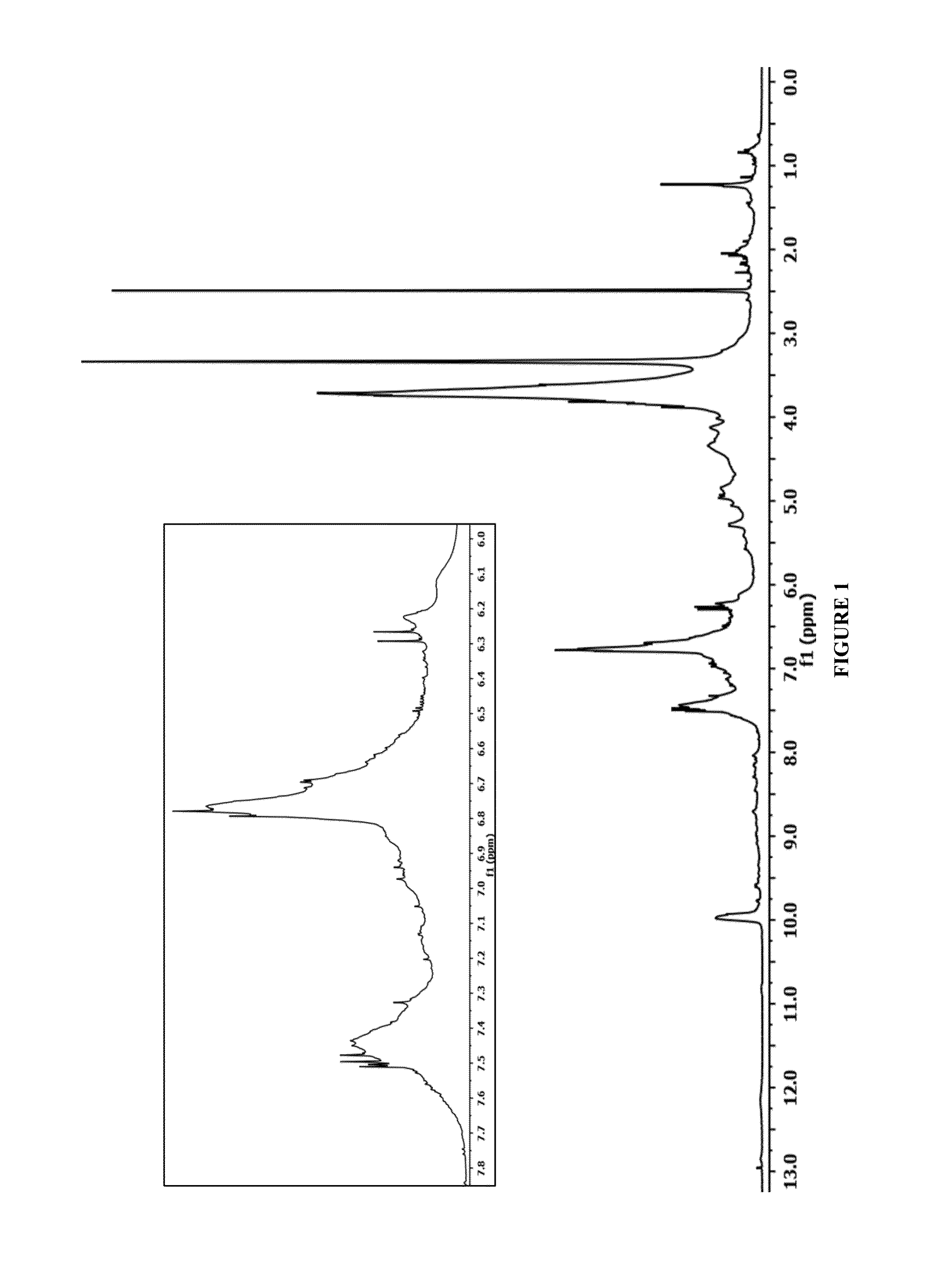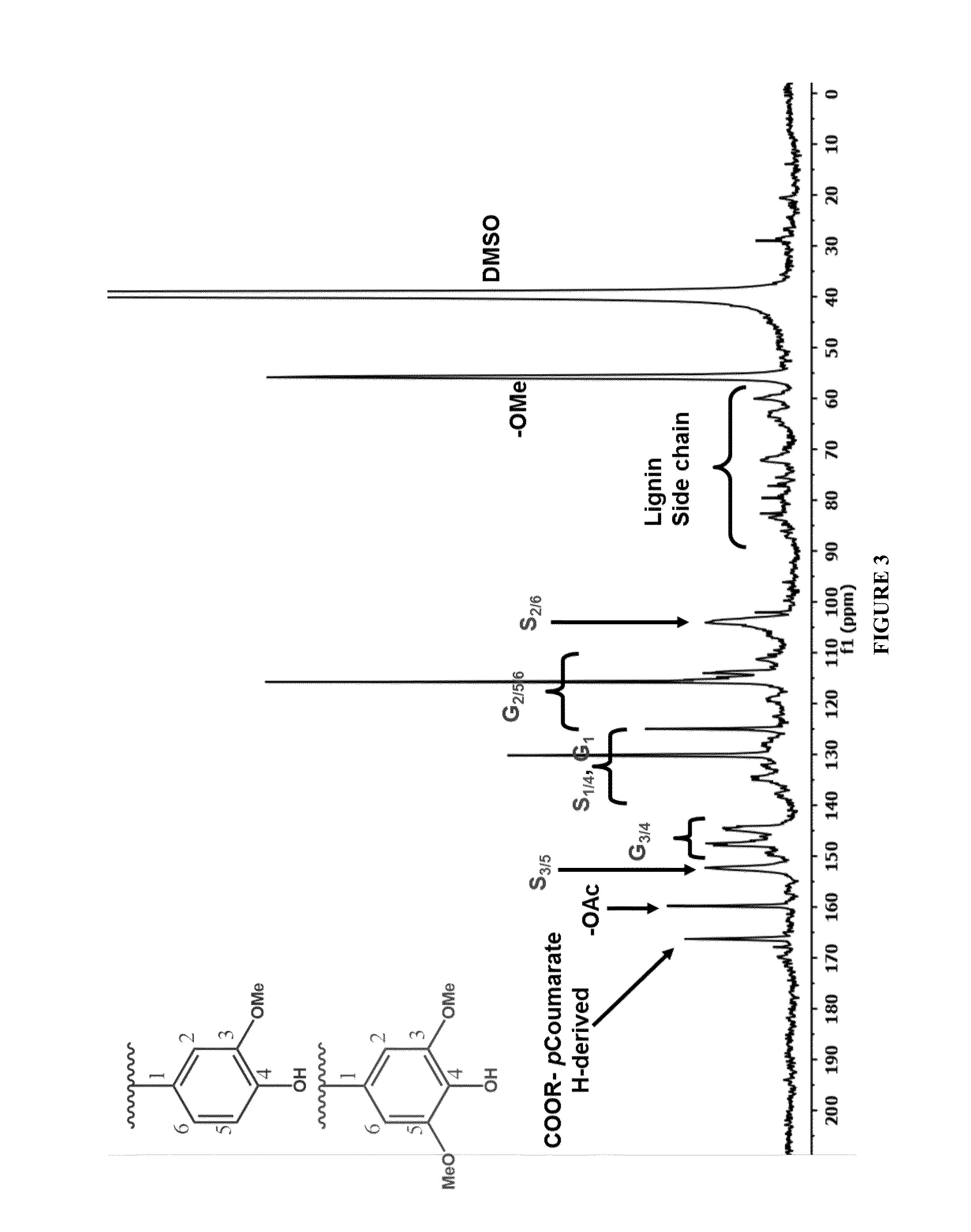Lignin Derivatives
- Summary
- Abstract
- Description
- Claims
- Application Information
AI Technical Summary
Benefits of technology
Problems solved by technology
Method used
Image
Examples
example 1
Recovery of Lignin Derivatives from Sugarcane Bagasse (SB-1)
[0045]The sugarcane bagasse used to make native lignin derivatives was harvested and extracted for sugars in Columbia in 2009. After drying and size reduction, via knife mill, to pass through a ½″ screen the sugarcane bagasse biomass was solubilized in PVT's countercurrent reactor (CCR) at 190° C. in 82:18:0.4 (by weight) acetone / water / sulfuric acid at a liquid flow rate of 723 g / minute and a dry biomass feed rate of 137 g / minute. SB-1 lignin isolates in the CCR liquid stream was purified by centrifugation to remove cellulosic fines, followed by heating the clarified liquid to 70° C. to reduce acetone and precipitate the lignin as an amorphous tar like material. The sugar rich liquid was decanted and the resulting tarry solids were re-solubilized in 80 mL of 7:1 acetone / water. This solution was then rotary evaporated to 50 mL, and the lignin was precipitated by slow addition of the concentrate into 1200 mL of water at neutr...
example 2
Recovery of Lignin Derivatives from Corn Stover CS-1
[0046]The corn stover used to prepare the native lignin derivatives was harvested in Northern Colorado on Nov. 20, 2013. The corn stover biomass was air dried then sized reduced via knife mill to pass through a ½″ screen. The size reduced corn stover biomass was solubilized in PVT's CCR at 200° C. in 90:10:0.3 acetone / water / sulfuric acid (w:w:w) at a liquid flow rate of 1408 g / minute and a dry biomass feed rate of 142 g / minute. CS-1 lignin was prepared from the CCR liquid stream by first settling the fines and decanting the clear liquid. Acetone in the clarified liquid was reduced by heating to 62° C. at 1 bar and the lignin in this concentrate was precipitated by slow addition of the resulting concentrate (150 mL) into 750 mL of aqueous H2SO4 at pH 4.1. The resulting lignin was isolated by filtration (Whatman 417), washed with water and dried in vacuo at 30° C.
example 3
Pilot Scale Recovery of Corn Stover Lignin Derivatives (CS-2) from Combined CCR Hydrolysate Fractions
[0047]Two liquid fractions from the CCR were combined to produce CS-2 lignin (Table 1). The first liquid fraction was produced where ground corn stover was solubilized with PVT's CCR in 90:10:0.3 acetone / water / sulfuric acid (w:w:w) at 200° C. with a liquid flow rate of 1400 g / minute and a dry biomass feed rate of 142 g / minute. The second fraction of solubilized corn stover was produced in the countercurrent reactor at 200° C. with 92:8:0.3 acetone / water / sulfuric acid (w:w:w) at a liquid flow rate of 1390 g / minute and a dry biomass feed rate of 125 g / minute. Cellulosic fines in the CCR liquid discharge were removed by sedimentation and decanting the clear liquid. The liquids were combined and concentrated with acetone reduction by heating to 60° C. and lignin in the concentrate was precipitated by slow addition of the concentrate to 5 volumes of water in a lignin precipitation system ...
PUM
| Property | Measurement | Unit |
|---|---|---|
| Fraction | aaaaa | aaaaa |
| Fraction | aaaaa | aaaaa |
| Fraction | aaaaa | aaaaa |
Abstract
Description
Claims
Application Information
 Login to View More
Login to View More - R&D
- Intellectual Property
- Life Sciences
- Materials
- Tech Scout
- Unparalleled Data Quality
- Higher Quality Content
- 60% Fewer Hallucinations
Browse by: Latest US Patents, China's latest patents, Technical Efficacy Thesaurus, Application Domain, Technology Topic, Popular Technical Reports.
© 2025 PatSnap. All rights reserved.Legal|Privacy policy|Modern Slavery Act Transparency Statement|Sitemap|About US| Contact US: help@patsnap.com



